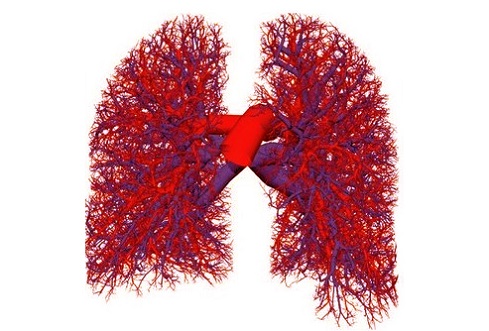Nikhil Prasad Fact checked by:Thailand Medical News Team Dec 16, 2024 3 months, 3 weeks, 6 days, 18 hours, 51 minutes ago
Medical News: The coronavirus disease 2019 (COVID-19) pandemic, caused by the SARS-CoV-2 virus, continues to reveal its many impacts on the human body. While much attention has been focused on its effects on the lungs and breathing, recent research now highlights how COVID-19 can drastically alter the pulmonary vasculature - the network of blood vessels in the lungs. This critical finding sheds light on potential long-term consequences for COVID-19 survivors.
 COVID-19 Causes Remodeling of the Pulmonary Vasculature
Researchers Uncover Changes in Lung Blood Vessels
COVID-19 Causes Remodeling of the Pulmonary Vasculature
Researchers Uncover Changes in Lung Blood Vessels
The study, which involved 56 autopsy samples, was conducted by a team of experts from multiple prestigious institutions, including Bogomolets National Medical University (Kyiv, Ukraine), Georgetown University Medical Center (Washington, USA), Ivano-Frankivsk Regional Clinical Hospital (Ukraine), and Medizinische Universität Lausitz - Carl Thiem (Germany). Their work provides a closer look at how COVID-19 leads to changes in the walls of small and medium-sized pulmonary arteries, altering their structure over time.
This
Medical News report delves into the study’s key findings, explaining in simple terms how the lungs’ blood vessels are affected and why it matters.
Pulmonary Vascular Remodeling: What Does It Mean?
When someone contracts COVID-19, the virus primarily attacks the lungs, causing inflammation and pneumonia. However, this study demonstrates that COVID-19 goes further by remodeling - or reshaping - the pulmonary vasculature. Over time, the walls of the arteries in the lungs thicken, and the space within the arteries (the lumen) narrows. This change can interfere with blood flow and may increase the risk of a condition called pulmonary arterial hypertension (PAH), a dangerous and long-term complication.
Researchers compared the lung tissues of COVID-19 patients with those of individuals who died of H1N1 influenza, a similar viral illness. The key difference? COVID-19 patients consistently showed more severe damage to their pulmonary arteries, including thickened walls and decreased lumen size.
Key Findings of the Study
The team observed several important changes in the lungs of COVID-19 patients:
-Hypertrophy of Smooth Muscle Layer
The smooth muscle layer of the pulmonary artery walls thickened significantly. This thickening, known as hypertrophy, was more pronounced after 14 days of illness. The longer the duration of COVID-19, the worse the damage.
-Perivascular Fibrosis
Fibrosis, or the formation of scar tissue, was found around the arteries. This happens due to inflammation triggered by the virus, which activates cells called fibroblasts to produce excess collagen. Fibrosis leads to stiff, thickened arteries that can restrict blood flow.
-Edema and Lymphostasis
Swelling, or edema, was observed in the arterial walls. This caused a
build-up of fluid and proteins, preventing proper drainage through the lymphatic system – a condition called lymphostasis. Over time, this contributes to the thickening of artery walls.
-Inflammatory Infiltration
In about 28% of cases, inflammatory cells were found infiltrating the arterial walls and surrounding areas. This inflammation further damaged the lung blood vessels.
-Hemosiderosis
Prolonged bleeding in the lungs led to hemosiderosis, a condition where iron deposits accumulate in tissues. The iron, carried by cells called siderophages, can contribute to oxidative stress and fibrosis.
-Neoangiogenesis
New blood vessels, a process called neoangiogenesis, were observed around the pulmonary arteries. While this may initially seem beneficial, these new vessels can add to the thickening and remodeling of artery walls.
-Thrombosis of Blood Vessels
Blood clots (thrombosis) were seen in pulmonary arteries and in smaller vessels called vasa vasorum. Thrombosis can worsen hypoxia - low oxygen levels - and cause further damage to artery walls.
A Worrying Trend: Pulmonary Hypertension
The researchers found a clear connection between the duration of illness and the extent of vascular remodeling. Patients who died more than 14 days after falling ill showed the most severe changes. This is concerning because these changes are similar to those seen in pulmonary arterial hypertension (PAH).
Pulmonary hypertension is a condition where increased pressure in the arteries of the lungs makes it harder for the heart to pump blood. Over time, this can lead to heart failure and other serious complications.
Implications for Survivors
While this study focused on deceased COVID-19 patients, the findings raise important questions about survivors. Could people who recover from COVID-19 develop similar long-term changes in their lung blood vessels? If so, they may be at risk of pulmonary hypertension in the future.
The researchers emphasize the need for ongoing medical evaluation of COVID-19 survivors, particularly those who experienced severe illness. Monitoring lung function and blood pressure in the pulmonary arteries may help detect problems early.
Why Is COVID-19 So Damaging to Blood Vessels?
The SARS-CoV-2 virus uses a protein called the spike protein to attach to human cells. This spike protein binds to a receptor called ACE2, which plays a critical role in regulating blood pressure. When the virus interferes with ACE2, it can trigger a chain reaction that damages blood vessels.
In addition, the study found evidence of the spike protein directly infiltrating the cells in the walls of pulmonary arteries, leading to inflammation, hypertrophy, and fibrosis. This direct attack may explain why COVID-19 causes such extensive vascular remodeling compared to other viral infections like H1N1 influenza.
Conclusion
This groundbreaking study provides clear evidence that COVID-19 causes remodeling of the pulmonary vasculature, leading to thickened arterial walls, fibrosis, and reduced lumen size. These changes are strongly associated with the duration of illness and may increase the risk of pulmonary arterial hypertension.
The findings underscore the need for ongoing monitoring of COVID-19 survivors, particularly those who suffered severe disease. Early detection and management of pulmonary vascular complications will be critical in preventing long-term health issues.
The study findings were published on a preprint server and are currently being peer reviewed.
https://www.biorxiv.org/content/10.1101/2024.12.12.628253v1
For the latest COVID-19 News, keep on logging to Thailand
Medical News.
Read Also:
https://www.thailandmedical.news/news/scientists-discover-shocking-pulmonary-microvascular-abnormalities-lingering-months-after-non-severe-covid-19-infections
https://www.thailandmedical.news/news/one-third-of-all-exposed-to-covid-19-likely-to-develop-cerebral-microbleeds
https://www.thailandmedical.news/articles/coronavirus
